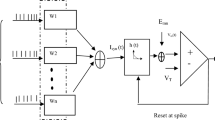Abstract
The Learning Algorithm for Multivariate Data Analysis (LAMDA) is an unsupervised fuzzy-based classification methodology. The operating principle of LAMDA is based on finding the datum-cluster relationship obtained by means of the Global Adequacy Degrees (GADs) of the Marginal Adequacy Degrees (MADs) of all the data attributes. In comparison with other unsupervised clustering algorithms, LAMDA does not require the number of classes as input parameter; however, in some applications, the quantity of obtained clusters does not correspond with the number of desired classes. Typically, this issue is overcome by merging interrelated clusters within the same class; nevertheless, in some applications the number of generated clusters related to the same class reaches a non-desired and impractical number. In LAMDA, the number of generated clusters is controlled by using a linear mixed connective with an exigency index α. This connective is an unnatural aggregation operator of the MADs, which adds an additional parameter to set up. In this paper, a full reinforcement operator (Yager–Rybalov Triple Π) is used as aggregation operator for merging the information contained in the MADs. This approach significantly reduces the number of generated classes and suppresses the LAMDA dependence of the parameter α. The proposed approach was tested in a case study related to unsupervised anuran vocalization recognition. A database of advertisement calls of six anuran (frog) species for testing this proposal was selected. All 102 vocalizations were correctly identified (100% of accuracy) and solely the desired classes were generated by the algorithm (establishing a cluster-class bijection).
Access this chapter
Tax calculation will be finalised at checkout
Purchases are for personal use only
Preview
Unable to display preview. Download preview PDF.
Similar content being viewed by others
References
Aguilar-Martin, J., López de Mantarás, R.: The process of classification and learning the meaning of linguistic descriptors or concepts. Approximate Reasoning in Decision Analysis, 165–175 (1982)
Duda, R.O., Hart, P.E., Stork, D.G.: Pattern Classification. John Wiley & Sons, New York (2001); J. Classif. 24(2) (September 2007)
Tzanakou, E.M.: Supervised and Unsupervised Pattern Recognition: Feature Extraction and Computational Intelligence. CRC Press, New York (2000)
Chang-Hsing, L., Chih-Hsun, C., Chin-Chuan, H., Ren-Zhuang, H.: Automatic recognition of animal vocalizations using averaged MFCC and linear discriminant analysis. Pattern Recognition Letters 27, 93–101 (2006)
Proceedings of the 4th International Workshop on Detection, Classification and Localization of Marine Mammals Using Passive Acoustics and 1st International Workshop on Density Estimation of Marine Mammals Using Passive Acoustics. Applied Acoustics 71(11), 991–1112 (November 2010)
Sánchez, M., Prats, F., Agell, N., Aguilar-Martin, J.: A Characterization of Linearly Compensated Hybrid Connectives Used in Fuzzy Classifications. In: ECAI, pp. 1081–1082. IOS Press (2004)
Yager, R.R., Rybalov, A.: Full reinforcement operators in aggregation techniques. IEEE Transactions on Systems, Man, and Cybernetics, Part B: Cybernetics 28(6), 757–769 (1998)
McCallum, M.L.: Amphibian Decline or Extinction? Current Declines Dwarf Background Extinction Rate. Journal of Herpetology 41, 483–491 (2007)
Bedoya, C., Uribe, C., Isaza, C.: Unsupervised Feature Selection Based on Fuzzy Clustering for Fault Detection of the Tennessee Eastman Process. In: Proceedings of the 13th Ibero-American Conference on Artificial Intelligence (IBERAMIA), Cartagena de Indias, Colombia, pp. 350–360 (2012)
Botía, J.F., Isaza, C., Kempowsky, T., Le Lann, M.V., Aguilar-Martín, J.: Automaton based on fuzzy clustering methods for monitoring industrial processes. Engineering Applications of Artificial Intelligence 26(4), 1211–1220 (2013)
Piera-Carrete, N., Desroches, P., Aguilar-Martin, J.: Variation Points in Pattern Recognition. Pattern Recognition Letters 11, 519–524 (1990)
Bedoya, C., Isaza, C., Daza, J.M., López, J.D.: Automatic Recognition of Anuran Species Based on Syllable Identification. Ecological Informatics 24, 200–209 (2014)
Isaza, C.: Diagnostic par Techniques d‘apprentissage Floues: Conception d‘une Methode de Validation et d‘optimisation des Partitions. PhD thesis, Laboratoire d’Analyse et d’Architecture des Syst‘emes du CNRS (October 2007)
Emilion, R., Regis, S., Doncescu, A.: A General Version of the Triple Pi Operator. International Journal of Iintelligent Systems, 1–18 (2013)
Ibañez, R., Stanley, A., Ryan, M., Jaramillo, C.: Vocalizaciones de ranas y sapos del Monumento Natural Barro Colorado. Parque Nacional Soberanía y áreas adyacentes. Sony MusicEntertaiment (Central America) S.A. (1999)
Selesnick, I.W., Burrus, C.S.: Generalized Digital Butterworth Filter Design. In: Proceedings of the IEEE Int. Conf. Acoust., Speech, Signal Processing, vol. 3 (May 1996)
Zhao, X., O’Shaughnessy, D.: A new hybrid approach for automatic speech signal segmentation using silence signal detection, energy convex hull, and spectral variation. In: Canadian Conference on Electrical and Computer Engineering, CCECE 2008, pp. 4–7 (May 2008)
Mermelstein, P.: Distance measures for speech recognition, psychological and instrumental. Pattern Recognition and Artificial Intelligence, 374–388 (1976)
Fox, E.: A new perspective on acoustic individual recognition in animals with limited call sharing or changing repertoires. Animal Behaviour 75, 1187–1194 (2008)
Author information
Authors and Affiliations
Editor information
Editors and Affiliations
Rights and permissions
Copyright information
© 2014 Springer International Publishing Switzerland
About this paper
Cite this paper
Bedoya, C., Waissman Villanova, J., Isaza Narvaez, C.V. (2014). Yager–Rybalov Triple Π Operator as a Means of Reducing the Number of Generated Clusters in Unsupervised Anuran Vocalization Recognition. In: Gelbukh, A., Espinoza, F.C., Galicia-Haro, S.N. (eds) Nature-Inspired Computation and Machine Learning. MICAI 2014. Lecture Notes in Computer Science(), vol 8857. Springer, Cham. https://doi.org/10.1007/978-3-319-13650-9_34
Download citation
DOI: https://doi.org/10.1007/978-3-319-13650-9_34
Publisher Name: Springer, Cham
Print ISBN: 978-3-319-13649-3
Online ISBN: 978-3-319-13650-9
eBook Packages: Computer ScienceComputer Science (R0)




